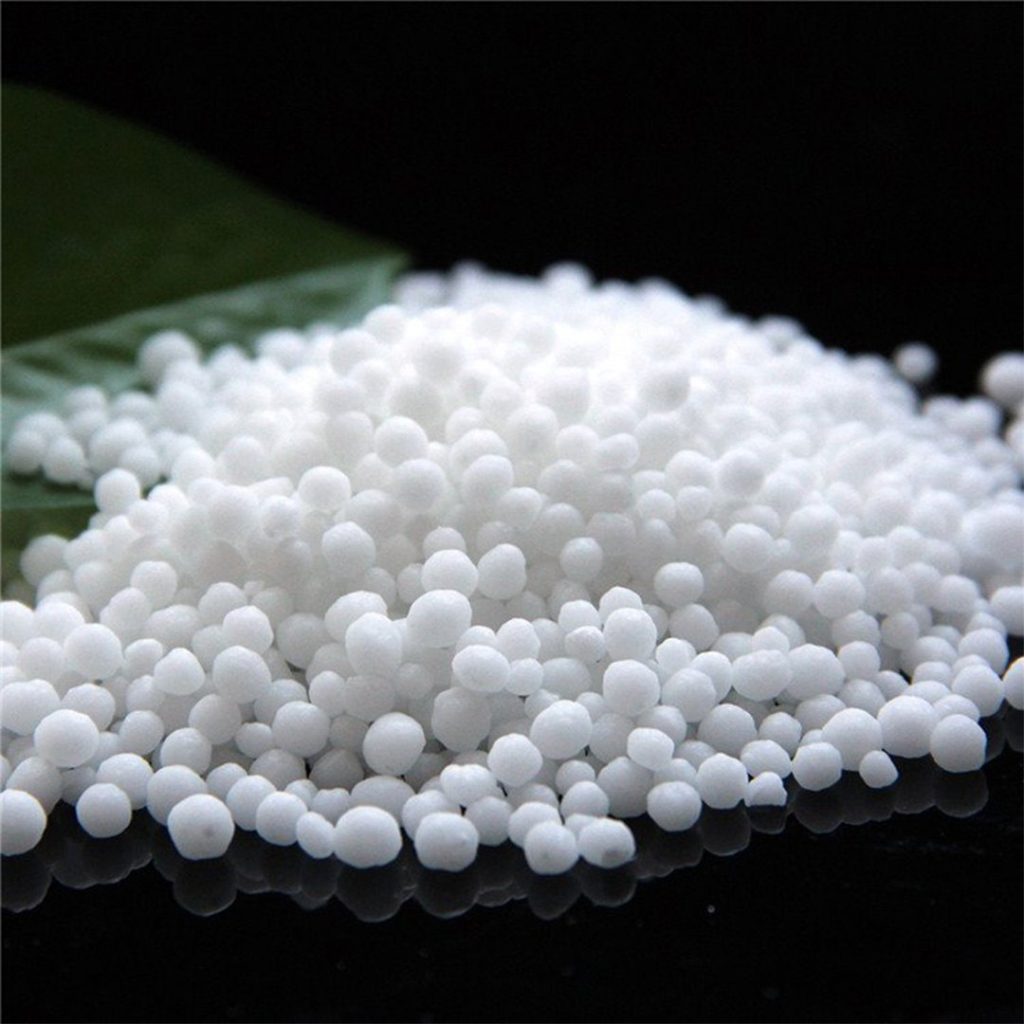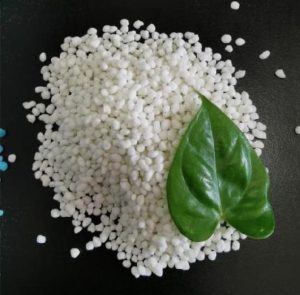Granular urea
Granular urea is an essential component of modern agriculture, primarily used as a nitrogen fertilizer. Its significance comes from its high nitrogen content, ease of use, and versatility in supporting the growth of a wide variety of crops. Let’s dive deeper into its characteristics, how it works in the soil, and the factors to consider when using it.
Composition and Structure of Urea:
Urea is a small, white, crystalline substance that is highly soluble in water. Chemically, it’s known as CO(NH₂)₂ and is a simple organic compound that contains 46% nitrogen by weight, the highest nitrogen content among solid fertilizers. In the case of granular urea, the substance is processed into granules, making it easier to handle, transport, and apply evenly to fields.
Nitrogen and Its Importance in Agriculture:
Nitrogen is one of the three essential nutrients for plant growth, the others being phosphorus and potassium. Nitrogen is crucial because it is a key component of chlorophyll, the green pigment in plants responsible for photosynthesis. It also plays a critical role in protein synthesis and overall plant health.
Without adequate nitrogen, plants exhibit slow growth, yellowing of leaves (chlorosis), and reduced yields. Crops like corn, wheat, rice, and many vegetables have high nitrogen demands, which makes fertilizers like granular urea so vital.

How Granular Urea Works:
When urea is applied to the soil, it undergoes a series of chemical transformations before the nitrogen becomes available to plants:
- Urea Hydrolysis: Once applied to the soil, urea reacts with water and the enzyme urease (naturally present in the soil) in a process called hydrolysis. This reaction breaks urea down into ammonium carbonate, which quickly converts into ammonia (NH₃).
- Ammonium Formation: The ammonia formed can be further converted to ammonium (NH₄⁺), which is a stable form of nitrogen that plants can absorb. However, some of the ammonia may volatilize (escape into the atmosphere) if the urea isn’t incorporated into the soil quickly.
- Nitrification: In moist soil, ammonium can be converted into nitrate (NO₃⁻) by nitrifying bacteria. Both ammonium and nitrate are forms of nitrogen that plants can absorb through their roots.
The ability of granular urea to break down into available nitrogen forms makes it a slow-release fertilizer. This characteristic ensures that nitrogen is gradually supplied to plants over time, improving nutrient uptake and minimizing waste.
Application Methods of Granular Urea:
Granular urea is flexible in terms of how it can be applied to crops:
- Broadcasting: The most common method, where urea is spread evenly across the soil. However, if left on the soil surface, urea may suffer from volatilization losses (ammonia gas escaping into the air). To reduce this, it’s recommended to incorporate the urea into the soil by tilling or applying it before rainfall.
- Banding: Urea can be placed in concentrated bands near the plant roots. This method reduces volatilization and improves nitrogen use efficiency by placing the fertilizer closer to the root zone.
- Fertigation: Urea is highly water-soluble, making it suitable for fertigation—applying the fertilizer through irrigation systems. This method ensures that nitrogen is directly delivered to the plant’s root zone.
- Foliar Spray: Urea can be diluted in water and sprayed directly onto plant leaves. This method provides a quick nitrogen boost, especially if the plant shows signs of nitrogen deficiency. However, excessive foliar application can burn leaves due to urea’s high concentration.
Factors Affecting Urea Efficiency:
While granular urea is widely used due to its cost-effectiveness and high nitrogen content, several factors can affect its efficiency:
- Volatilization: When urea is applied to the soil surface without incorporation, especially under warm and dry conditions, it can volatilize and result in nitrogen loss as ammonia gas. Incorporating urea into the soil or applying it before rainfall can reduce these losses.
- Leaching: Urea, when converted to nitrate (NO₃⁻), can be prone to leaching, especially in sandy or waterlogged soils. Nitrate is highly soluble in water and can move deep into the soil profile, out of the reach of plant roots, or contaminate groundwater.
- Soil pH: The breakdown of urea can cause a temporary increase in soil pH, especially around the granules. This localized increase in alkalinity can harm plant roots in sensitive crops. However, this effect is typically short-lived and can be managed with proper application techniques.
- Soil Temperature and Moisture: Urea works best when soil conditions are moist and warm, as the hydrolysis process (urea breakdown) depends on water and microbial activity. Cold or dry conditions can slow down the conversion of urea to plant-available nitrogen
Environmental Considerations:
While urea is an efficient nitrogen fertilizer, its improper use can have negative environmental consequences. The two main concerns are:
- Ammonia Volatilization: This is when urea nitrogen is lost to the atmosphere as ammonia gas, contributing to air pollution and decreasing fertilizer efficiency.
- Nitrate Leaching: As nitrate is highly mobile in the soil, excessive use of urea can lead to groundwater contamination, especially in regions with high rainfall or poor drainage. Nitrate pollution of water sources is a serious issue as it can harm aquatic life and pose health risks to humans.
Enhanced Urea Products:
To improve the efficiency of urea and reduce environmental risks, enhanced urea products have been developed. These include:
- Urea with Urease Inhibitors: These additives slow down the conversion of urea to ammonia, reducing volatilization losses and allowing more time for rain or irrigation to incorporate the urea into the soil.
- Coated Urea: Urea granules can be coated with sulfur or polymer materials to slow down the release of nitrogen, making it a controlled-release fertilizer. This is especially useful in high-value crops like turfgrass, vegetables, and fruit trees, where consistent nitrogen availability is needed.
Benefits of Granular Urea:
- High Nitrogen Efficiency: With 46% nitrogen content, it is one of the most concentrated nitrogen fertilizers, reducing the quantity needed and lowering transportation costs.
- Versatile: Urea can be used in different crops, soil types, and climates, making it suitable for a wide range of farming systems.
- Cost-Effective: It is relatively inexpensive compared to other nitrogen sources, which is why it is favored by large-scale farmers.
In conclusion, granular urea is a highly effective nitrogen fertilizer that plays a crucial role in modern agriculture. Its high nitrogen content and versatility make it a staple for farmers worldwide. However, to maximize its benefits and reduce environmental impact, proper application methods and timing must be followed.
(FAQ)
What is granular urea used for?
Granular urea is primarily used as a nitrogen fertilizer in agriculture. It provides an essential nutrient (nitrogen) that supports plant growth, helps in chlorophyll production, and promotes higher crop yields
What is the nitrogen content in granular urea?
Granular urea contains about 46% nitrogen by weight, making it one of the most concentrated nitrogen fertilizers available.
How does granular urea work in the soil?
When applied to soil, urea breaks down into ammonia and carbon dioxide through a process called hydrolysis. Ammonia is converted into ammonium, which plants can absorb. The ammonium may also convert to nitrate, another form of nitrogen that plants can utilize.
Can urea be harmful to plants?
If applied excessively or improperly, urea can cause “fertilizer burn” to plants, particularly when too much nitrogen is present. Urea should be applied in recommended amounts, and foliar applications should be diluted to prevent leaf scorching.
What happens if urea is left on the soil surface?
If not incorporated into the soil, urea can lose nitrogen through volatilization, where ammonia gas escapes into the atmosphere. This can lead to a reduction in the nitrogen available to plants and decreased fertilizer efficiency.
Is urea safe for the environment?
Urea can contribute to environmental issues if misused. Nitrate leaching from urea can contaminate groundwater, and volatilized ammonia can cause air pollution. Proper management practices, like incorporating urea into the soil, using inhibitors, and not overapplying, can mitigate these effects.
How long does it take for urea to break down in soil?
Urea typically breaks down within a few days to a week, depending on soil temperature, moisture levels, and microbial activity. Warmer and moist conditions speed up the process, while cold or dry conditions slow it down.
Can urea be mixed with other fertilizers?
Yes, but it should be done with caution. Urea can be mixed with certain fertilizers but can react with others (e.g., superphosphate), leading to the formation of compounds that may affect nutrient availability. Consult agronomists or fertilizer guides to ensure proper mixing.
What precautions should be taken when storing urea?
Urea is highly soluble in water and hygroscopic (absorbs moisture from the air), so it should be stored in a dry place and in tightly sealed containers. Exposure to moisture can cause urea granules to clump or dissolve.
Can urea be used in organic farming?
No, urea is considered a synthetic fertilizer, so it is generally not allowed in organic farming practices. Organic farmers typically use natural sources of nitrogen like compost, manure, or cover crops.
What is coated urea?
Coated urea is urea that has been covered with a polymer or sulfur coating. This coating slows the release of nitrogen, providing a controlled, long-lasting source of nitrogen. This is useful for crops that benefit from steady nitrogen availability over time.
Why does urea need to be managed carefully in agriculture?
Urea’s high nitrogen content means that improper application can lead to nitrogen losses through volatilization, leaching, or runoff. These not only reduce the effectiveness of the fertilizer but can also have negative environmental impacts. Proper timing, incorporation into the soil, and use of inhibitors can help manage these risks.
